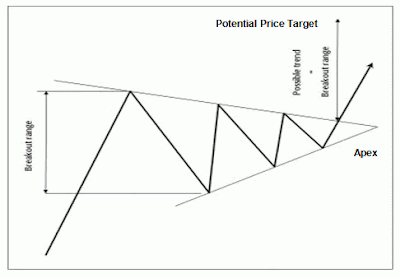Symmetrical Triangle is a neutral pattern that normally forms during a trend (either uptrend or downtrend) as a continuation / consolidation pattern. The breakout usually occurs in the same direction as the existing trend.
The Formation of Symmetrical Triangle Pattern
Symmetrical Triangle Pattern contains at least two lower highs (peaks) and two higher lows (troughs). When the peak as well as trough points are connected by separate lines and then extended to the right, they would respectively form a descending upper line and an ascending lower line, creating a pattern that looks like a symmetrical triangle.
In this case, the descending upper line acts as resistance, whereas the ascending lower line as support.
This pattern occurs because the highs (peaks) are moving progressively lower, whereas the lows (troughs) are moving progressively higher.
As the range between the peaks and troughs are narrowing, the upper & lower lines converge at the "Apex", which is located at the right of the triangle.
The completion of the pattern occurs when prices break out through either the upper line (i.e. breakout to the upside) or lower line (i.e. breakout to the downside) before finishing the apex of the triangle.
A triangle pattern may sometimes be associated with a �coil�. A �coil� needs to recoil (contract) in order to build up enough potential energy for its next expansion.
The pattern implies that buyers and sellers are in a period where they still hesitate where the market is heading. However, in the end, either the buyers or sellers managed to find enough conviction to break out to one side with great force.
To be continued to Part 2: Important Characteristics of Symmetrical Triangle pattern.
To read about other chart patterns, go to: Learning Charts Patterns.
Related Posts:
* Learning Candlestick Charts
* Options Trading Basic � Part 2
* Understanding Implied Volatility (IV)
* Option Greeks
SYMMETRICAL TRIANGLE PATTERN � Part 1: Formation
 10:43 PM
10:43 PM
 killnine
killnine



